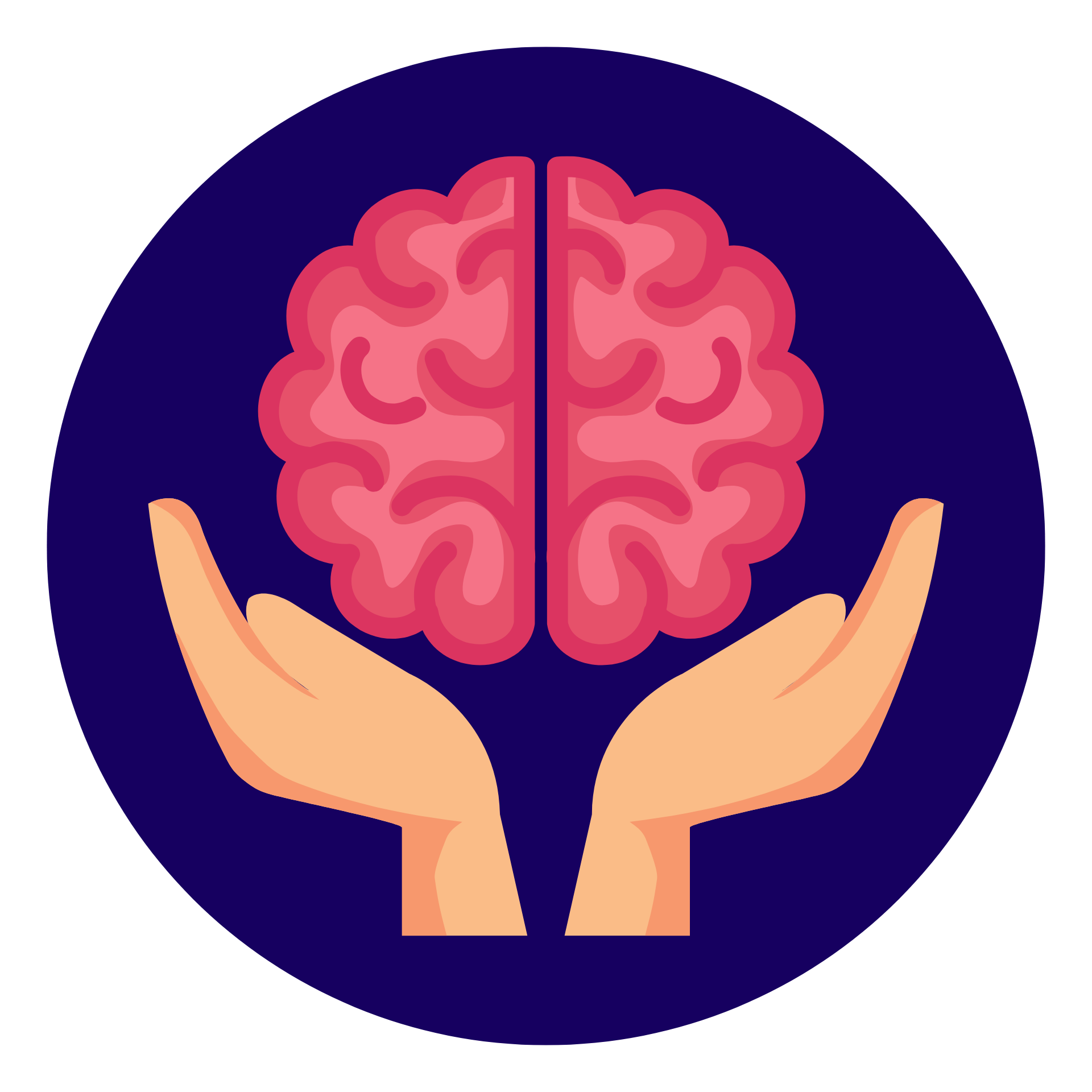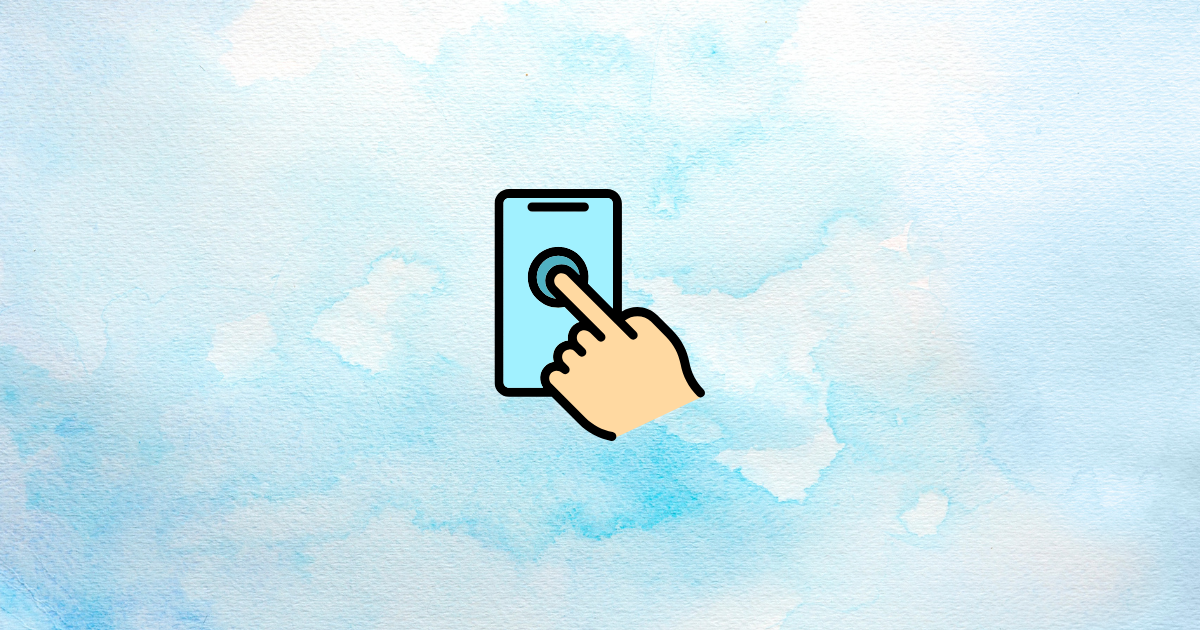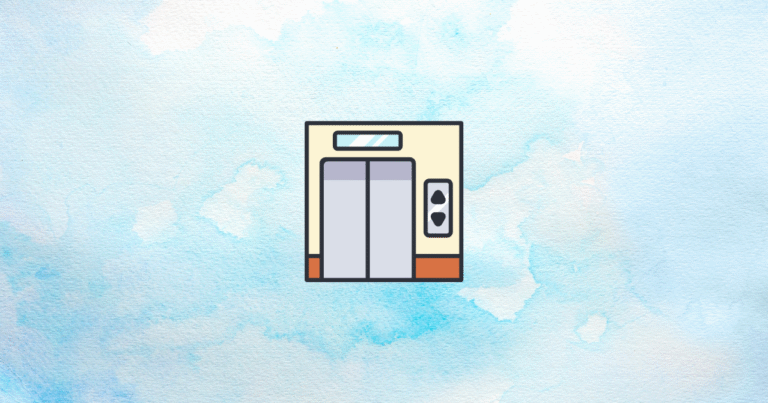Have you ever wondered why some Shopify stores convert visitors into loyal customers while others struggle to make a single sale? The secret isn’t just about having great products or flashy designs – it’s about understanding and optimizing the emotional journey your customers experience at every touchpoint. Think about it: when was the last time you made a purchase based purely on logic without any emotions involved?
In this article, you’ll discover how to map and enhance the emotional arc of your Shopify customer’s journey. By the time you finish reading, you’ll understand how the science of emotions drives purchasing decisions and how you can leverage this knowledge to dramatically improve your conversion rates, customer loyalty, and overall store performance. Ready to transform your Shopify store into an emotion-optimized selling machine? Let’s dive in!
Theoretical Foundations of Emotional Journey Mapping
Before we jump into tactics, let’s understand the science behind why emotions matter so much in e-commerce. This foundation will help you make smarter decisions about your store’s customer experience.
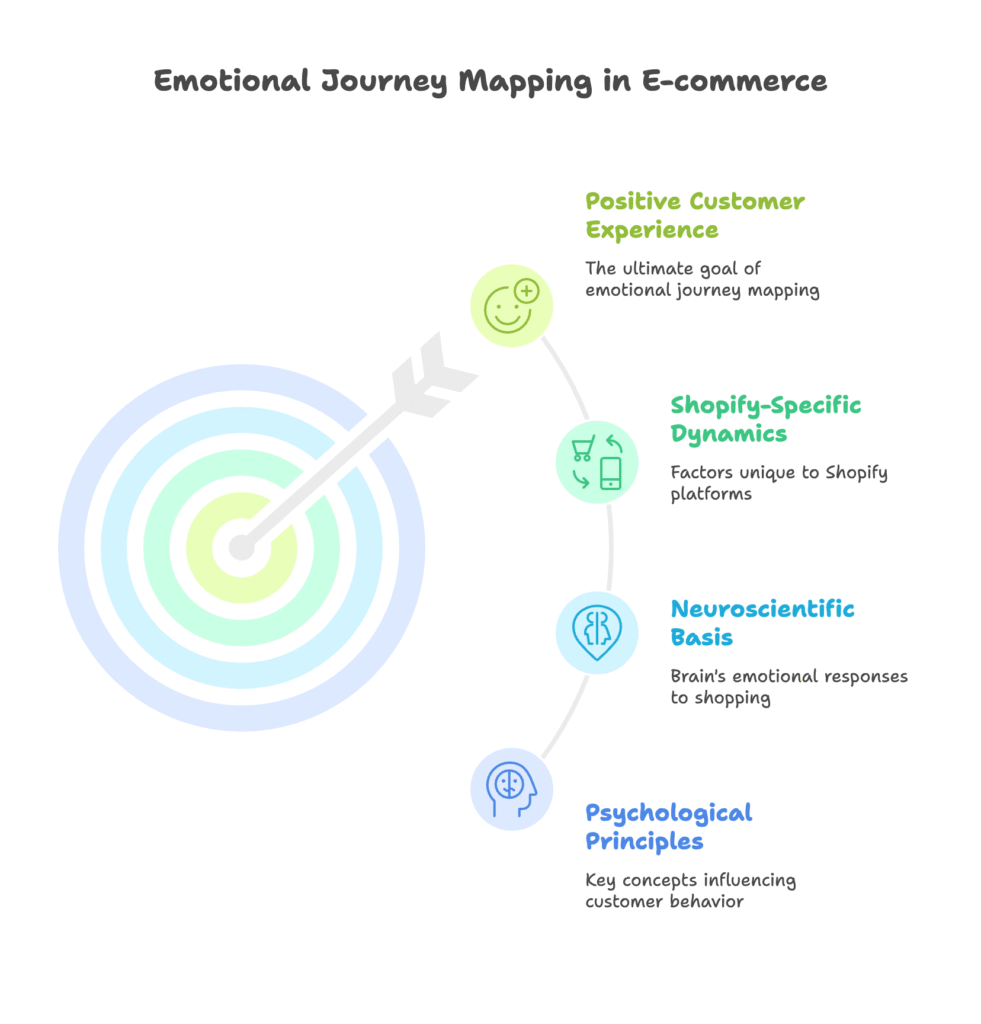
Psychological Principles
Three key psychological principles influence how customers experience your Shopify store:
- The Peak-End Rule: People don’t remember entire experiences—they remember the emotional peaks (the highest or lowest points) and how the experience ended. This means optimizing the most emotionally charged moments in your customer journey can have an outsized impact on how people remember their experience with your brand.
- Dual-Processing Theory: Customers make decisions using two systems: the fast, intuitive, emotional System 1, and the slower, more analytical System 2. While customers might believe they’re making rational decisions, their emotional System 1 often drives the initial interest and final purchase trigger.
- Affective Forecasting: Shoppers try to predict how a purchase will make them feel in the future. Your job is to help them imagine positive emotional outcomes accurately, whether it’s joy, relief, pride, or belonging.
Understanding these principles helps explain why seemingly minor elements of your store—like colors, fonts, and image choices—can dramatically impact conversion rates.
Neuroscientific Basis
Our brains are wired to respond emotionally to shopping experiences:
- The amygdala activates when customers perceive risk during checkout, triggering the fight-or-flight response that can lead to cart abandonment if not properly addressed.
- Dopamine releases not just when customers make a purchase, but actually peaks during the anticipation phase—explaining why “coming soon” announcements and wishlists can be so powerful.
- Oxytocin, often called the “trust hormone,” plays a crucial role in building post-purchase relationships. Personal thank-you notes, thoughtful packaging, and follow-up communications can trigger oxytocin release and strengthen customer loyalty.
Shopify-Specific Dynamics
Several factors make emotional journey mapping particularly important for Shopify stores:
- Mobile-first emotional processing: With over 70% of Shopify traffic now coming from mobile devices, understanding how emotions work differently on smaller screens (where trust is harder to establish and frustration happens faster) is essential.
- Cognitive load thresholds: Shopify stores with too many options, complex navigation, or cluttered designs can overwhelm customers, triggering negative emotions that lead to abandonment.
- The paradox of choice: More options often lead to less satisfaction and decision paralysis. The most successful Shopify stores carefully curate their product offerings and guide customers toward the right choices.
Now that we understand why emotions matter so much, let’s explore how they unfold throughout the customer journey. Ready to see how to map this emotional landscape and identify opportunities to create more positive experiences? Let’s move on to the framework that will transform how you think about your customer journey!
The 5-Stage Emotional Journey Framework
Every customer who interacts with your Shopify store goes through a predictable emotional arc. By understanding the feelings that dominate each stage, you can design experiences that address emotional needs at precisely the right moment.
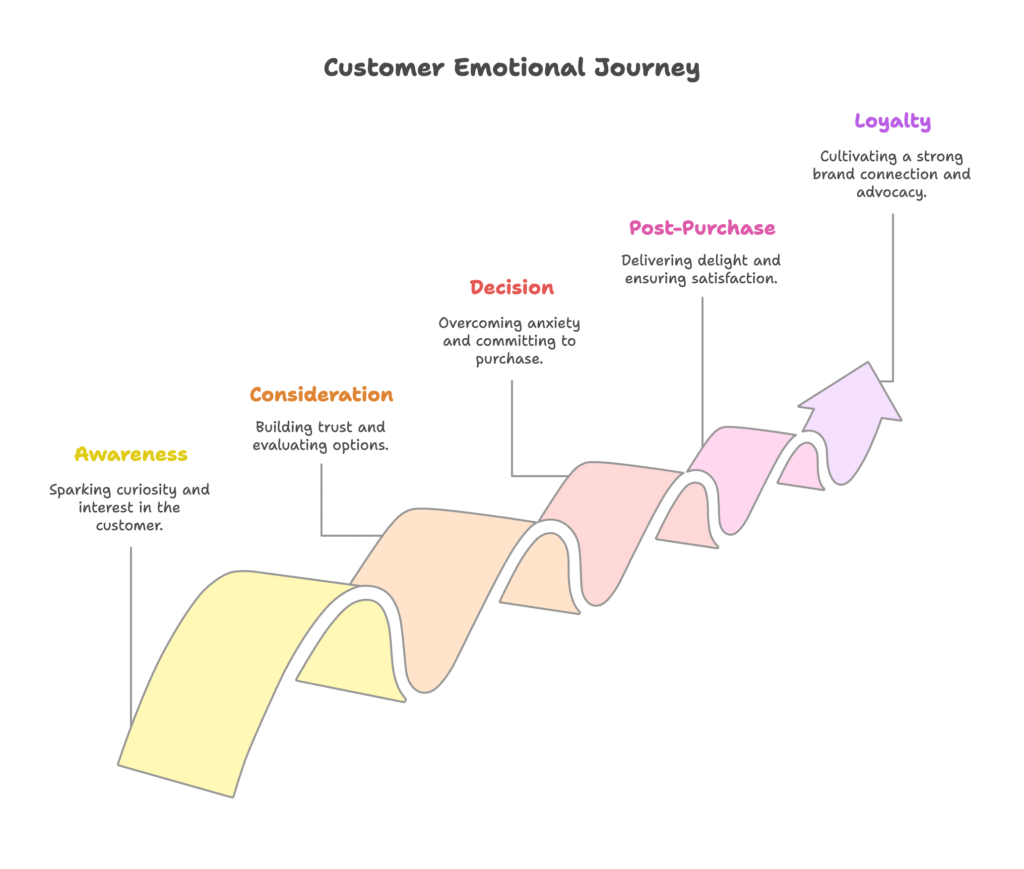
Awareness Stage: Sparking Curiosity
The emotional states customers experience during the awareness stage typically move from intrigue to skepticism to tentative interest. Your goal is to nurture positive emotions while minimizing negative ones.
Key Touchpoints:
- Social media ads: Research shows that ads using visual storytelling generate 68% higher emotional engagement than product-focused ads. Stories activate the brain’s empathy centers, making customers more receptive to your message.
- Influencer content: Micro-influencers (those with 10,000-50,000 followers) boost trust by 42% compared to celebrity endorsements because they feel more authentic and relatable.
- SEO-optimized blog posts: Content that directly answers customer questions creates cognitive fluency—the ease with which our brains process information—leading to more positive first impressions.
Optimization Strategies:
- Use “mystery box” techniques in ad creatives that hint at solutions without revealing everything, increasing click-through rates by up to 33% by triggering curiosity.
- Implement schema markup for featured snippets in search results, reducing bounce rates by up to 50% by setting proper expectations before the first click.
The awareness stage is all about making a positive first impression that sparks curiosity without triggering skepticism. But once you’ve captured their attention, how do you build the trust necessary for consideration? Let’s explore that next…
Consideration Stage: Building Trust
During consideration, customers move through emotions of doubt, comparison, and eventually cautious optimism. This emotional transition is crucial—if customers remain stuck in doubt, they’ll never convert.
Key Touchpoints:
- Product comparison tools: Interactive features that help customers evaluate options reduce decision fatigue by 27%, preventing the negative emotions that lead to abandonment.
- User-generated content galleries: Authentic customer photos and videos increase perceived authenticity by 41%, addressing the skepticism that naturally arises during consideration.
- Live chat support: Stores offering immediate responses to pre-purchase questions see conversion rates increase by 3.2x because they address emotional barriers in real-time.
Optimization Strategies:
- Add “Why Us” widgets that transparently compare your offerings to competitors, acknowledging that customers are comparing anyway and building trust through honesty.
- Implement AI-powered review summaries that highlight emotional benefits mentioned by previous customers, increasing trust metrics by 19%.
By the end of the consideration stage, customers should feel confident enough to move toward a decision. But the most intense emotional battle happens next, when customers face the moment of truth. How do we help them overcome the anxiety that kicks in at decision time? Let’s find out…
Decision Stage: Overcoming Friction
The decision stage is an emotional rollercoaster, with customers experiencing anxiety that must transform into confidence before reaching commitment. This is where most Shopify stores lose sales—not because of price or product concerns, but because of unaddressed emotional barriers.
Key Touchpoints:
- Dynamic checkout buttons: One-click solutions like Shop Pay increase conversions by 18% by reducing the anxiety associated with complicated checkout processes.
- Trust badges: Prominently displayed SSL and security seals reduce cart abandonment by 29% by addressing subconscious fear of data theft.
- Limited-stock counters: Genuine inventory indicators create urgency through fear of missing out (FOMO), increasing conversion by up to 37% when implemented ethically.
Optimization Strategies:
- Use progressive disclosure in checkout flows, asking for simpler information first and gradually moving to more sensitive details, reducing overwhelming feelings.
- Implement biometric payment authentication options where available, increasing security perception by 22% and reducing last-minute abandonment.
Once a customer has made it through the emotional hurdles of the decision stage and completed a purchase, many stores make the mistake of thinking the emotional journey is complete. But some of the most important emotional moments happen after the buy button is clicked. Let’s explore this crucial next stage…
Post-Purchase Stage: Delivering Delight
After purchasing, customers typically experience satisfaction that can either evolve into pride and advocacy potential or deteriorate into regret and disappointment. The post-purchase experience is where customer lifetime value is truly determined.
Key Touchpoints:
- Unboxing experience design: Thoughtful packaging increases social shares by 45%, as customers want to show off purchases that arrive in memorable ways.
- Personalized replenishment reminders: Timely, helpful notifications about reordering increase customer lifetime value by 33% by making customers feel cared for rather than just sold to.
- Surprise upgrades: Unexpected enhancements or gifts reduce return rates by 58% by creating emotional high points that offset any minor product disappointments.
Optimization Strategies:
- Provide AR-powered assembly or usage guides that help customers get maximum value from their purchase, enhancing satisfaction.
- Create “Share Your Story” incentives that reward customers for telling others about their positive experiences, reinforcing their good feelings about the purchase.
The post-purchase stage sets the foundation for the ultimate goal: turning one-time buyers into loyal, repeat customers. But how do you build the emotional connection that transforms satisfaction into true loyalty? That’s where the final stage comes in…
Loyalty Stage: Cultivating Tribal Identity
The loyalty stage is characterized by emotions of belonging, exclusivity, and ultimately evangelism, where customers not only return but actively promote your brand to others. This is where profit margins truly expand.
Key Touchpoints:
- VIP membership tiers: Structured loyalty programs that offer escalating benefits increase repeat purchase frequency by 27% by creating a sense of status and belonging.
- User-generated content challenges: Community activities like photo contests increase engagement by 63% by fostering connections between customers with shared interests.
- Co-creation opportunities: Involving customers in product development reduces churn by 41% by creating psychological ownership of the brand’s future.
Optimization Strategies:
- Implement blockchain-based loyalty tokens that customers can collect, trade, or redeem, adding an engaging element of gamification.
- Use neural sentiment analysis to identify emotional patterns in customer feedback, enabling hyper-personalized communications that resonate with individual values.
Now that we understand the complete emotional arc, you might be wondering: how do we actually map and measure these emotions in practice? Let’s explore the tools and techniques that make emotional journey mapping actionable rather than just theoretical…
Mapping Tools & Techniques
Turning emotional journey mapping from theory into practice requires the right set of tools. Here’s how to gather the data you need to understand your customers’ emotional experiences.
Shopify-Specific Analytics Stack
Several tools integrate seamlessly with Shopify to help track emotional metrics:
| Tool | Emotional Metric | Insight Application |
|---|---|---|
| Hotjar | Attention heatmaps | Identify frustration points where users get stuck or confused |
| Klaviyo | Email engagement sentiment | Tailor post-purchase sequences based on response patterns |
| Yotpo | Review emotion scoring | Improve product social proof by highlighting emotional benefits |
Neurometric Measurement
For businesses ready to invest in deeper insights, neurometric tools offer fascinating windows into customer emotions:
- EEG Headbands: Though primarily used in research settings, these can measure prefrontal cortex activity during the checkout process, revealing cognitive load peaks where customers might be experiencing decision stress.
- Facial Coding: Remote testing services can analyze micro-expressions as participants browse your store, revealing subtle emotional reactions that customers themselves might not even consciously recognize.
- Galvanic Skin Response: Measuring changes in sweat gland activity during mobile navigation can identify moments of frustration or excitement that might otherwise go undetected.
Emotional Arc Visualization
Once you’ve gathered data, visualizing the emotional journey helps identify opportunities for improvement. A sample customer journey map might look like this:
[Awareness] Intrigue (7/10) → [Consideration] Doubt (4/10) → [Decision] Anxiety (6/10) →
[Post-Purchase] Delight (9/10) → [Loyalty] Pride (8/10)
This visualization immediately highlights the consideration and decision stages as emotional valleys where improvements could have the biggest impact.
With our tools in place, let’s see how real businesses have applied these concepts to achieve impressive results. These case studies will show you what’s possible when you optimize for emotions throughout the customer journey…
Case Studies & Results
The proof of emotional journey mapping lies in the results. Here are three examples of Shopify stores that dramatically improved performance by optimizing emotional touchpoints.
Luxury Skincare Brand: 141% ROAS Increase
Challenge: A premium skincare brand was struggling with high traffic but low conversion rates. Analysis revealed customers were experiencing skepticism during the consideration stage due to high price points.
Tactic: The brand implemented emotional storytelling in product videos, focusing not on ingredients or technical benefits but on the emotional transformation customers experienced after using the products. They featured real customers telling personal stories about how the products made them feel.
Results: Time spent on product pages increased by 58%, and return rates decreased by 33%. Most importantly, return on ad spend (ROAS) increased by 141%, as visitors who clicked ads were much more likely to complete purchases.
Electronics Retailer: 29% Higher AOV
Challenge: A Shopify store selling premium electronics found customers experiencing anxiety during the decision stage, unsure if products would meet their needs and work in their spaces.
Tactic: They implemented anxiety-reducing AR product previews, allowing customers to visualize exactly how products would look and fit in their homes. This addressed the emotional fear of making the wrong choice.
Results: Support queries about product specifications decreased by 41%, showing reduced customer uncertainty. Average order value increased by 29% as customers felt confident enough to purchase higher-end models.
Subscription Box Service: 63% Retention Rate
Challenge: A food subscription box was facing high churn after the third month, indicating a failure to develop emotional loyalty beyond the initial novelty period.
Tactic: They implemented post-purchase “achievement unlocked” emails that celebrated customer milestones (first box, third box, six months, etc.) and shared the positive impact of their subscription (e.g., “You’ve now tried 24 new ingredients!”). This created a sense of progress and accomplishment.
Results: Customer retention increased to a 63% rate after six months (industry average is 43%). User-generated content submissions increased by 22% as customers became emotionally invested in sharing their experiences.
These results are impressive, but implementing emotional journey mapping also comes with ethical responsibilities. Let’s explore how to enhance the customer experience while respecting boundaries and building authentic relationships…
Ethical Implementation Guidelines
Emotional journey mapping is powerful—and with that power comes responsibility. Here’s how to ensure your approach respects customers and builds genuine relationships.
Dark Pattern Prevention
Avoid manipulative tactics that create short-term gains but destroy long-term trust:
- Transparency Standards: Clearly differentiate between ads and organic content. Never use fake testimonials or reviews. Customers can spot inauthenticity, and the resulting emotional damage to your brand is nearly impossible to repair.
- Genuine Inventory Counters: If you show “only 3 left!” indicators, they must reflect actual inventory. Fake scarcity techniques create a temporary FOMO but lead to long-term distrust when discovered.
Emotional Wellbeing Protections
Respect customers’ emotional boundaries and avoid creating negative feelings:
- Addiction Safeguards: Limit push notifications to no more than three per day to avoid overwhelming customers. Create mandatory cool-off periods after cart abandonment rather than bombarding shoppers with reminders.
- Pressure-Free Shopping: While urgency can be effective, excessive countdown timers or high-pressure language can create anxiety that customers associate with your brand long after they leave your store.
Inclusive Design
Ensure all customers can experience positive emotions when interacting with your store:
- Cognitive Accessibility: Offer dyslexia-friendly product descriptions with clear fonts and spacing. This isn’t just about accessibility—it’s about making sure every customer can experience the joy of easily understanding your offerings.
- ASL Video Guides: For complex products, consider American Sign Language video guides. This inclusivity creates powerful emotional connections with customers who are often overlooked in e-commerce experiences.
As technology evolves, the opportunities for emotional journey mapping continue to expand. Let’s look ahead at what’s coming next in this fascinating field…
Future of Emotional Journey Engineering
The intersection of technology and emotional understanding is creating exciting new possibilities for Shopify merchants willing to stay ahead of the curve.
Emerging Technologies
Watch for these innovations that are beginning to reshape emotional journey mapping:
- AI Emotion Engines: Advanced algorithms that can adjust product descriptions, email content, and even pricing in real-time based on detected customer sentiment and browsing patterns.
- Biometric Checkout: Systems that can authenticate payments using pulse patterns or fingerprints, creating a sense of security while reducing friction to a single tap.
- Metaverse Showrooms: Virtual spaces where customers can experience products emotionally before purchasing, with those emotional experiences persisting seamlessly between digital and physical interactions with your brand.
Predictive Models
The future of emotional journey mapping lies in prediction rather than just reaction:
- Emotional LTV Forecasting: Neural networks that can predict customer lifetime value based on emotional response patterns in early interactions, allowing for more personalized retention strategies.
- Churn Risk Scores: Advanced session recording tools that can detect stress indicators (like rapid mouse movements or repeated clicking) and flag customers who might need proactive support.
Conclusion
The emotional journey of your Shopify customers isn’t just an abstract concept—it’s the most powerful lever you have for increasing conversions, building loyalty, and growing your business. By understanding the psychological principles, mapping the five key stages, implementing the right tools, and following ethical guidelines, you can create experiences that resonate on a deeply human level.
Remember that emotions drive decisions far more than logic, and customers who feel positive emotions throughout their journey are more likely to buy, return, and recommend your store to others.
Ready to take your Shopify store’s performance to the next level? Consider using Growth Suite, a powerful Shopify app that helps you implement many of the emotional journey optimization techniques we’ve discussed. With its ability to track visitor behavior, predict purchase intent, and deliver personalized, time-limited offers to the right customers at the right time, Growth Suite can help you create genuine urgency that drives conversions while maintaining your brand’s integrity.
Start mapping your customers’ emotional journey today, and watch as understanding leads to connection, connection leads to conversion, and conversion leads to lasting success for your Shopify store.
